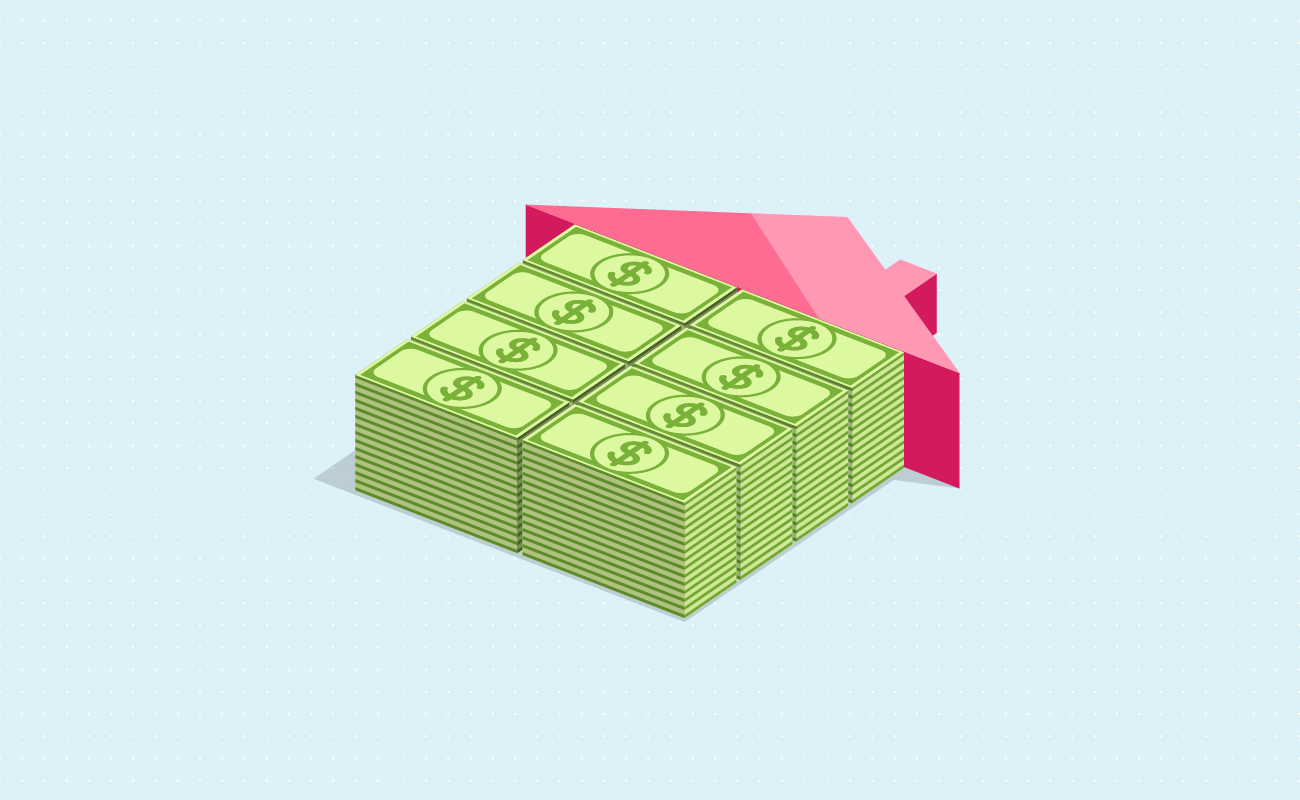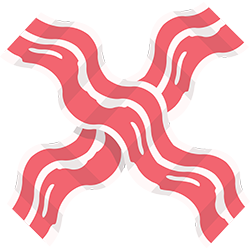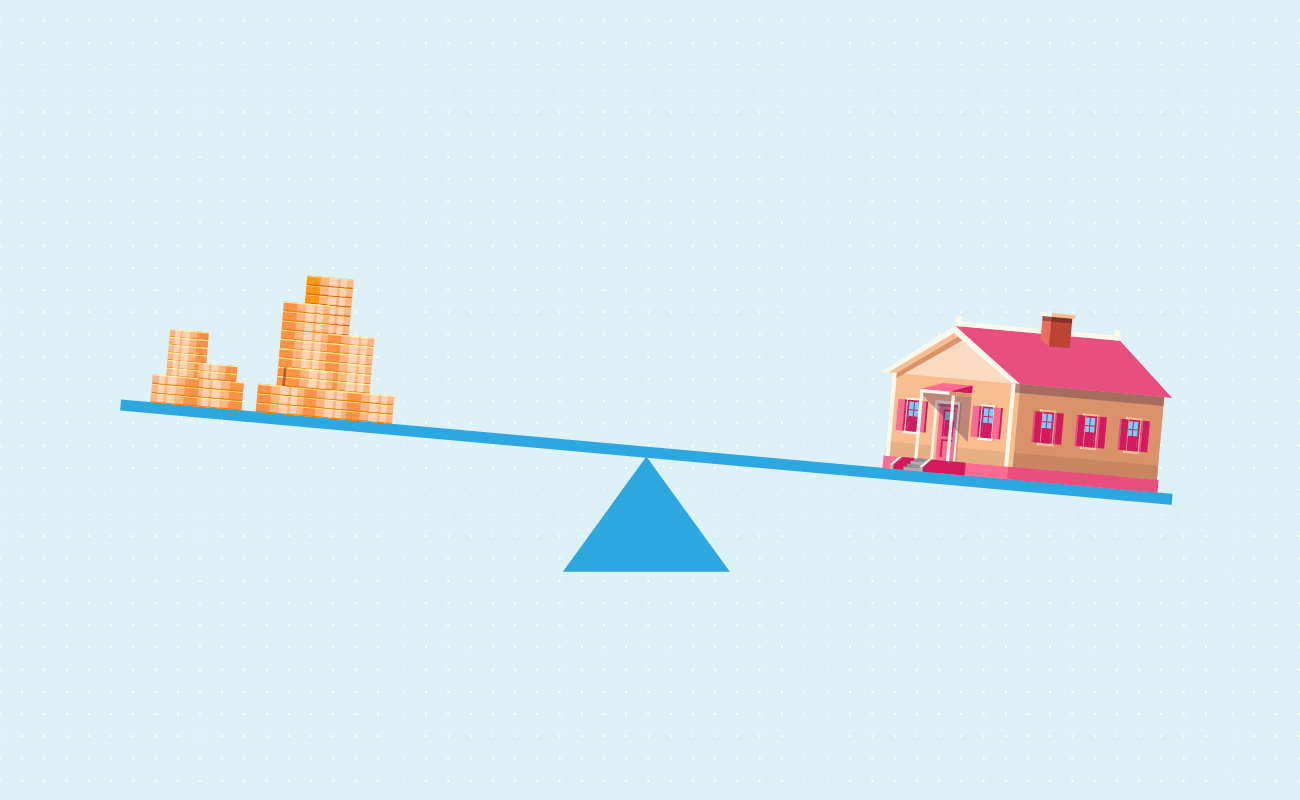Fixed Rates
30 yr
25 yr
20 yr
15 yr
10 yr
Compare Terms
Compare Rates
Real APR
Adjustable Rates
Qualification
Affordability
Renter Affordability
Rent vs Buy
Price per Square Foot
Jumbo
Home Sellers
 Cash Out Refi Calculator
Cash Out Refi CalculatorThis page offers two calculators to help homeowners estimate how much equity they can extract from their home when they refinance and figure what their monthly payments will be on their new home loan. The first tab calculates the loan size you can qualify for and the second tab calculates your monthly payments. These calculators presume you want to extract equity from your home. If you want to refinance without extracting equity, please instead use either our standard refinancing calculator or our mortgage consolidation calculator. Once you have entered all of your details you can use the button at the bottom of the calculator to create a printable amortization schedule.
Guide published by Jose Abuyuan on September 8, 2020

Home equity is a major source of wealth for many Americans. Though it can remain illiquid for years, people with enough home equity can tap this resource for important expenses.
Being equity-rich means you have at least 50 percent equity in your home. Apart from the benefit of homeownership, it enables you to cash out in the future. You can use this money to finance major costs, such as home improvement projects, student loans, or even expensive medical bills. Some homeowners also use it to consolidate high-interest debts.
To access your home equity, you can take advantage of cash-out refinancing. Our guide below will discuss what it is and how it compares to other types of loans. We’ll also talk about its pros and cons as well as the right situations to consider this option.
Then, we’ll discuss financing alternatives that allow you to access home equity. These include second mortgages, such as home equity lines of credit (HELOC) and home equity loans. Once you’re aware of these options, you can better decide if cash-out refinancing suits your needs.
Cash-out refinancing involves replacing your original mortgage with a new loan that is higher than your outstanding balance. The money that you “cash out” is the difference between your original mortgage and new loan. The lump sum amount is given to you after closing the deal.
Like traditional refinancing, the new mortgage pays for your old mortgage. It also changes your interest rate, adjusts your loan term, or both. Depending on your preference, you can refinance to a lower rate with a much shorter term. You also need at least 20 percent home equity to bypass property mortgage insurance (PMI) requirements.
In cash-out refinancing, expect the interest rate to be slightly higher than it would be if you did not extract equity during refinancing. This is because you’re borrowing a higher loan amount and the lender will take on higher risk with your loan having a higher loan-to-value ratio. It’s the tradeoff you make for withdrawing a percentage of your home equity. Likewise, expect your monthly payment to change.
For instance, let’s suppose your home is valued at $200,000 and you have a remaining balance of $100,000. This means your home equity is worth $100,000. Now, if you need $50,000 to repair your house, you can take advantage of cash-out refinancing. You can refinance your $100,000 loan balance into $150,000, allowing you to withdraw $50,000 upon closing. Then, you must pay back your loan as stated in the new terms of your mortgage.

The economic distress brought by COVID-19 caused the world economy to go into a recession, which led to a projected $6 billion loss for Fannie Mae and Freddie Mac. Because of this, both GSEs published lender guides announcing they will impose a 50 basis point Adverse Market Refinance Fee.
The fee was originally set on September 1, 2020 but was moved to December 1, 2020 to cushion the shock on mortgage originators. It will be assessed for both cash-out and non-cash-out refinances. Refinances with a balance under $125,000 are not assessed this fee. Homeowners who want to avoid this 0.5% refinance fee should apply by early October so the loan can still be approved before the December 1 deadline.
Just like traditional refinancing, you must get your financial standing in order before you apply for this loan. Prepare to fulfill these requirements before applying for cash-out refinancing:
Prepare the following documents:

There’s a limit to how much you can cash-out when you refinance. For conventional loans, you are allowed to take between 80 percent to 90 percent of your home equity.
Meanwhile, for government-backed loans, the Federal Housing Authority grants cash-out refinancing of up to 85 percent equity on FHA home loans. The U.S. Department of Veterans Affairs, on the other hand, allows up to 90 percent home equity for cash-out refi VA loans. The U.S. Department of Agriculture, however, does not provide cash-out options for refinancing on USDA loans. Many people who have government sponsored loans switch to conventional loans when they refi to bypass ongoing insurance requirements.
For example, let’s say you’ve been paying your 30-year fixed-rate mortgage at 5 percent APR for 16 years. You bought it at $375,000, but its appraised value is now $450,000. Your current mortgage balance is $194,296.
Using the calculator above, let’s estimate how much money you can qualify for depending on the appraised percentage. This is based on the loan-to-value (LTV) ratio, which is the measure of the loan amount against the market value of the house securing your loan. See the table below:
| Percent Appraised | 75% LTV | 80% LTV | 85% LTV | 90% LTV |
|---|---|---|---|---|
| Maximum debt | $337,500 | $360,000 | $382,500 | $405,000 |
| Less existing debt | $194,296 | $194,296 | $194,296 | $194,296 |
| Your credit limit | $143,204 | $165,704 | $188,204 | $210,704 |
| Remaining home equity | $112,500 | $90,000 | $67,500 | $45,000 |
The table shows that as LTV gets higher, your maximum debt and credit limit also increases. Consequently, obtaining a higher debt lowers your remaining home equity.
Based on the example, your maximum debt at 75 percent LTV will be $337,500, which means you can borrow $143,204. This leaves you with a home equity of $112,500. Meanwhile, at 90 percent LTV, your maximum debt will $405,000, allowing you to borrow $210,704. However, you’ll be left with a much lower home equity, which is $45,000.

Before choosing cash-out refinance, know exactly how much you need. This will help you avoid borrowing too much equity, which makes your loan harder to pay back. And when your home is on the line, you must make sure you can sustain monthly payments.
Similar to traditional mortgage refinancing, cash-out refinancing costs around 2 percent to 5 percent of your loan’s value. This is a significant amount, so carefully assess your financial situation before taking this option. For example, if you have a $300,000 loan, that’s between $6,000 to $15,000. If you cannot afford the closing costs lenders can roll them into the loan, though doing so will further increase the amount owed and the total interest you will pay over the life of the loan.
Closing costs include origination fees, appraisal and inspection fees, and title insurance fees. If you decide to refinance early, you may also be charged a prepayment penalty fee by your lender. Mortgage brokers may charge a loan origination fee and banks may offer you lower interest rates using discount points.

Origination fees are the payment you give to your lender to process your loan. The amount varies, which means a particular lender can charge more than others. To reduce your closing costs, try to negotiate your origination fees.
While it depends on your lender, the processing time for cash-out refinances is typically between 45 to 60 days from the date of application. In particular, appraisals by third-party home inspectors can take time. Be sure to factor this when estimating your schedule. Moreover, don’t expect to receive your cash right after closing.
Under federal law, the Truth in Lending Act requires lenders to provide a 3-day grace period in case you need to cancel the loan. This usually means you’ll receive the money within 3 days or so after closing. It’s enough time to change your mind if you think you’re not ready.
Cash-out refinancing is ideal for people who want to borrow a significant amount while refinancing into a new mortgage. If you’re determined to change your loan term or rate, this option is ideal for you. However, if you you’re happy with your current mortgage and just need to borrow money, you should consider other loan options.
Some of the benefits of cash-out refinancing include lower interest rates compared to credit cards, personal loans or second mortgages. And unlike personal loans, a new mortgage can give you a longer time to pay for your debt. Moreover, you are not required to pay private mortgage insurance (PMI) if you borrow below 80 percent of your home’s value. If you have a vacation home, you can also tap home equity from your property. Borrowers who use the money to improve their home may qualify for tax deductions.
As for the drawbacks, cash-out refinancing is harder to qualify for. You typically must have at least 20 percent home equity, a credit score of 620, and a back-end DTI ratio of no more than 50 percent. The processing and closing time may take up to two months. If you need cash right away you will need to tap other options, as refinancing approval takes time. You must also consider the current interest rate and expensive closing costs. If you’re planning to borrow over 80 percent LTV, you’re required to pay private mortgage insurance. This is another expense on top of a large debt. Finally, because the loan is secured by your home, you risk losing it to foreclosure if you fail to pay your debt.

Think twice before consolidating high-interest credit card debt with a cash-out refinance. If you run a large debt on your credit cards again, you may struggle with repayment. Do not put your house on the line if you think your budget cannot handle it.
The following table summarizes the pros and cons of taking cash-out refinancing:
| Pros | Cons |
|---|---|
| Lower interest rate than credit cards, personal loans or second mortgages | Has strict lending requirements that make it hard to qualify |
| No private mortgage insurance (PMI) if you borrow less than 80% of your home’s value | Private mortgage insurance (PMI) is required if you borrow over 80% of your home’s value |
| Allows you to borrow a large amount against your home equity, between 80% – 90% | The application process can take 45-60 days, while you can borrow money right away with a credit card |
| Has a longer repayment term compared to personal loans | Has higher interest rates compared to traditional refinancing |
| You may qualify for a mortgage interest tax deduction if you use the money to buy, build, or improve your home | Comes with expensive closing costs which ranges between 2%-5% of your loan |
| You can pay-off high-interest debt with a low-interest loan, allowing you to save on interest costs | Using cash-out refinancing to pay credit card debt is risky, especially if you incur credit card debt again |
| For conventional loans, you can also tap home equity from vacation homes and rental property | You can lose your home to foreclosure if you fail to pay back your loan |
Now let’s see how cash-out refinancing compares to other types of financing. We’ll focus primarily on unsecured loans and their difference when it comes to rates.
Cash out refinancing has lower interest rates compared to credit cards. Credit cards are an example of unsecured debt, which means they are not backed by any collateral in case you default on your loan. For this reason, credit cards have much higher interest rates.
The average credit card rate is 16 percent as of September 2020, according to Creditcards.com. Meanwhile, the refinancing rate for a 30-year fixed mortgage is around 3.110 percent in September 2020. You save more on interest charges if you choose a low-interest loan. Credit cards, on the other hand, may give you immediate access to cash for any purchases. But unless you’re a conscientious spender, you can easily incur toxic debt. Credit card balances should be paid in full each month to take advantage of the grace period without incurring high interest expenses.
Personal loans are another type of unsecured debt, which means they also have higher interest rates compared to cash-out refis. For instance, as of September 2020, a personal loan has an interest rate between 5.99 percent to 18.83 percent. This is for a loan amount ranging from $5,000 to $100,000 with a loan term within 2 to 7 years. Again, you end up paying higher interest when you take this type of debt. However, the approval process is quicker than a mortgage.

There are other ways to tap your home equity without refinancing your loan. This entails taking out a second mortgage. The two types of second mortgage are a home equity loan and a home equity line of credit (HELOC). Most second mortgages are structured as a HELOC.

A second mortgage, as the name indicates, is another loan taken against a house that already has a mortgage. In exchange for tapping your home equity, your second lender takes a lien against a portion of your home that you’ve paid off. Unlike cash-out refinancing, this is a completely separate loan from your current mortgage. It means that while you’re paying your original mortgage, you are making another payment to your second lender.
If you fail to repay your original mortgage, your second lender can only get paid once your original lender is paid back. Because of this, second mortgages may have a higher interest rate compared to cash-out refinancing. The higher rate may turn off potential borrowers, so they choose a cash-out refi instead. However, a second mortgage has more affordable closing costs compared to cash-out refis since the loan or credit line is much smaller.
Before the 1980s homeowners had an aversion to second mortgages though rebranding the term as "home equity" led to widespread usage, with many homeowners using their houses like ATMs in the lead up to the 2008 financial crisis.

"Prior to the 1980s, the term home equity didn't even exist. It's fascinating. A home equity loan prior to the 1980s was called a second mortgage. Now, a second mortgage doesn't sound very nice. You know, if you already have an aversion to debt, a second mortgage is kind of like, OK, now I already had one handcuff on, and now you're going to put, you know, ankle cuffs on me.
So there was a systematic effort - and this is all quite well documented; and in fact, we looked at our own data to see if this was true - to actually invent this term home equity. And the idea was, well, it's your equity in your home. You have every right to borrow against it. It's not a bad thing to borrow against that equity." - Amir Sufi
When credit market conditions tighten some banks opt to tighten lending standards by lowering LTV limits and increasing minimum credit scores. Some may temporarily leave the second mortgage market as JPMorgan Chase and Wells Fargo did in April of 2020 after the impact of COVID-19 was felt across the global economy. Many homeowners are under forebearance programs which allow them to miss payments during the crisis, elevating the risks to lenders offering second mortgages. According the the Mortgage Bankers Association (MBA) 8.48% of home loans - 4.2 million loans - were in forebearance as of June 14.
Looking at the prior economic cycle, in the second quarter of 2008 HELOCs represented 20.3% of mortgage originations. In the subsequent year throughout the Great Recession their share fell to 8.6%.
Obtaining a second mortgage can work for you if you want to borrow against your home equity without changing your rate and term. To keep your original loan, you can compromise by paying a slightly higher interest rate. Just make sure you can manage making two mortgage payments throughout the life of your loan.
Furthermore, you have the option to choose how to withdraw your home equity. You can obtain it as a revolving line of credit if you choose a HELOC. But if you want a one-time lump sum amount, you can get through a home equity loan.
Around 90% of all second mortgages are structured as HELOCs.
A HELOC provides you with a line of credit that works much like a credit card. Consider this option over cash-out refinancing if you’re paying for expenses throughout an extended period of time.
HELOCs allow you to withdraw cash up to an approved limit while paying interest against the amount you owe. You can borrow money as needed during the “draw period” instead of taking out one lump sum amount. This typically lasts for 10 years, where you must make monthly interest and principal payments. After the draw period, you can no longer borrow further. The remaining term is dedicated to repayment.
Furthermore, HELOCs come with a variable interest rate which may rise or fall depending on market conditions. That said, you must prepare to make larger payments if interest rates increase. If rates decrease, you have the advantage to make smaller payments. This is worth considering, especially if you’re going to keep your credit line for 20 years. And just like a credit card, it may be tempting to withdraw frequently. So keep track of your withdrawals to avoid incurring a large debt.
HELOCs generally do not charge closing costs, though you may pay $300 or $400 for home appraisal. Unused lines may have an annual fee of up to $100 to keep the account active.

If you’re not comfortable with a variable rate and you’re looking to change your mortgage, cash out refinancing will work for you. You get to refinance to a shorter term or lower rate without having to put up with unpredictable monthly payments. Plus, you don’t have to make payments on two mortgage debts.
A home equity loan comes as a one-time lump sum cash. If you’re looking to cash out all your money at once, this option can work for you. Consider a home equity loan if you’re looking to borrow a specific amount of money to fund major expenses. Other people may also use it to consolidate large debts.
Unlike HELOC, a home equity loan comes with a fixed-rate term. This means your monthly payments remain the same throughout the life of the loan. The terms range between 5, 15, and 30 years. The predictable payments make sure you can afford your mortgage and you have enough time to pay it back.
If a new mortgage rate is similar to your current rate, and you don’t want to borrow a large sum, a home equity loan can work better for you. Unlike cash-out refinancing, you don’t have to change your current mortgage. While home equity loans typically charge a closing cost of between 2% to 5% this cost is only applied to the amount borrowed. Paying 5% of a $40,000 home equity loan is $800, whereas a 5% closing cost on a $250,000 home would cost $12,500.

If you’re determined to change your mortgage while borrowing a large sum, consider cash-out refinancing instead. This way you don’t have to pay for two mortgages, especially if you’re not happy with the terms on your original loan.
Senior citizens may want to consider reverse mortgages which allows they to extract equity without payment due until they change residences, sell the home, or perish. These loans come in three main types:
HECM reverse mortgages can be structured to allow cash to be withdrawn using any of the following structures
Fintech companies are offering a new wave of alternative funding options to tradtional second mortgages and reverse mortgages. Companies like Hometap, Unison, Point, and Noah allow homeowners to sell fractional shares of their home equity outright. This allows homeowners to tap equity without needing to make immediate loan payments, though when the property is sold or the investment contract term is completed at 10 years the homeowner repays the fintech firm a pro-rated amount based on their equity stake.
While these products are new it may make sense to take a wait-and-see approach. While any particular company may be great at any given point in time, company management or ownership can change in a way that changes their policies. That in turn can cause unforeseen issues for homeowners. The traditional mortgage industry has many consumer protections built into their contracts with events like the Great Depression and the Great Recession leading to further consumer protections being embedded in contracts.

Accessing home equity is a viable strategy to improve your financial picture. Cash-out refinancing is a way to tap your home equity to fund important expenses. Other ways to access home equity is by taking a HELOC or home equity loan.
But before tapping your home equity, make sure to use the money for a worthwhile cause. It won’t be a good idea if you use it to purchase a car or fund an expensive vacation. These things will give you minimal to no return on your money. Instead, use it to finance important costs like home improvement projects. This can increase the value of your home, which helps rebuild your equity. Another good way to use it is to invest in a lucrative business venture. Other people tap home equity to pay for their child’s college education, which is another major life investment.
Finally, make sure you have a stable source of income to repay your loan. Try to obtain the lowest rate possible to maximize interest savings, which makes it easier to manage your debt.
Thinking of consolidating your first and second mortgage? Use our mortgage consolidation refinance calculator.
Jose Abuyuan is a web content writer, fictionist, and digital artist hailing from Las Piñas City. He is a graduate of Communication and Media Studies at San Beda College Alabang, who took his internship in the weekly news magazine the Philippines Graphic. He has authored works professionally for over a decade.